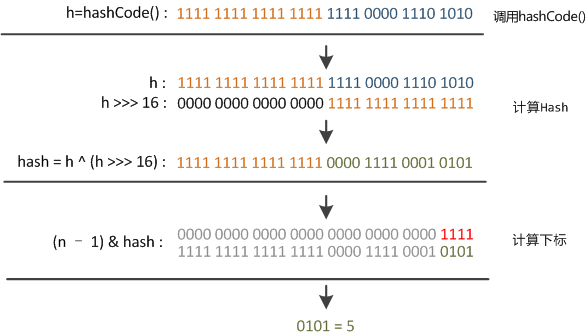HashMap和ConcurrentHashMap源码解读
-
a.对key的hashCode进行hash,然后再计算index;
-
b. 如果没有碰撞直接放到桶bucket里
-
c.如果碰撞里了,以链表的形式存在bucket里
-
d.如果碰撞导致链表长度过长(大于等于TREEIFY_THRESHOLD),就把链表转换为红黑树
-
e.如果节点已经存在就替换old value(保证key的唯一性)
-
f.如果bucket满了(超过load factor*current capacity),就要resize.
public V put(K key, V value) {
//对key的hashCode进行hash
return putVal(hash(key), key, value, false, true);
/**
* Implements Map.put and related methods
*
* @param hash hash for key
* @param key the key
* @param value the value to put
* @param onlyIfAbsent if true, don't change existing value
* @param evict if false, the table is in creation mode.
* @return previous value, or null if none
*/
final V putVal(int hash, K key, V value, boolean onlyIfAbsent,
boolean evict) {
Node<K,V>[] tab; Node<K,V> p; int n, i;
// table未初始化或者长度为0,进行扩容
if ((tab = table) == null || (n = tab.length) == 0)
n = (tab = resize()).length;
// (n - 1) & hash 确定元素存放在哪个桶中,桶为空,新生成结点放入桶中(此时,这个结点是放在数组中)
if ((p = tab[i = (n - 1) & hash]) == null)
tab[i] = newNode(hash, key, value, null);
// 桶中已经存在元素
else {
Node<K,V> e; K k;
// 比较桶中第一个元素(数组中的结点)的hash值相等,key相等
if (p.hash == hash &&
((k = p.key) == key || (key != null && key.equals(k))))
// 将第一个元素赋值给e,用e来记录
e = p;
// hash值不相等,即key不相等;为红黑树结点
else if (p instanceof TreeNode)
// 放入树中
e = ((TreeNode<K,V>)p).putTreeVal(this, tab, hash, key, value);
//该链为链表
else {
// 在链表最末插入结点
for (int binCount = 0; ; ++binCount) {
// 到达链表的尾部
if ((e = p.next) == null) {
// 在尾部插入新结点
p.next = newNode(hash, key, value, null);
// 结点数量达到阈值,转化为红黑树
if (binCount >= TREEIFY_THRESHOLD - 1) // -1 for 1st
treeifyBin(tab, hash);
// 跳出循环
break;
}
// 判断链表中结点的key值与插入的元素的key值是否相等
if (e.hash == hash &&
((k = e.key) == key || (key != null && key.equals(k))))
// 相等,跳出循环
break;
// 用于遍历桶中的链表,与前面的e = p.next组合,可以遍历链表
p = e;
}
}
// 表示在桶中找到key值、hash值与插入元素相等的结点
if (e != null) { // existing mapping for key
// 记录e的value
V oldValue = e.value;
// onlyIfAbsent为false或者旧值为null
if (!onlyIfAbsent || oldValue == null)
//用新值替换旧值
e.value = value;
// 访问后回调
afterNodeAccess(e);
// 返回旧值
return oldValue;
}
}
// 结构性修改
++modCount;
// 实际大小大于阈值则扩容
if (++size > threshold)
resize();
// 插入后回调
afterNodeInsertion(evict);
return null;
}
复制代码
get操作
-
a.bucket里的第一个节点直接命中
-
b.如果由冲突,则通过key.equals(k)去查找对应的entry
-
如果为树,则在树中通过key.equals(k)查找,时间复杂度为o(logn);
-
如果为链表,则在链表中通过key.equals(k查找),时间复杂度为o(n);
public V get(Object key) {
Node<K,V> e;
return (e = getNode(hash(key), key)) == null ? null : e.value;
}
/**
* Implements Map.get and related methods
*
* @param hash hash for key
* @param key the key
* @return the node, or null if none
*/
final Node<K,V> getNode(int hash, Object key) {
Node<K,V>[] tab; Node<K,V> first, e; int n; K k;
if ((tab = table) != null && (n = tab.length) > 0 &&
// 直接命中
(first = tab[(n - 1) & hash]) != null) {
if (first.hash == hash && // always check first node
((k = first.key) == key || (key != null && key.equals(k))))
return first;
// 未命中
if ((e = first.next) != null) {
//在树中get
if (first instanceof TreeNode)
return ((TreeNode<K,V>)first).getTreeNode(hash, key);
// 在链表中get
do {
if (e.hash == hash &&
((k = e.key) == key || (key != null && key.equals(k))))
return e;
} while ((e = e.next) != null);
}
}
return null;
}
复制代码
hash函数的实现
在get和put的过程中,计算下标时,先对hashCode进行hash操作,然后再通过hash值进一步计算下标,如下图所示

static final int hash(Object key) {
int h;
// ^ :按位异或
// >>>:无符号右移,忽略符号位,空位都以0补齐
//其中n是数组的长度,即Map的数组部分初始化长度
return (key == null) ? 0 : (h = key.hashCode()) ^ (h >>> 16);
}
复制代码
我们可以看到,在 hashmap 中要找到某个元素,需要根据 key 的 hash 值来求得对应数组中的位置。如何计算这个位置就是 hash 算法。
前面说过,hashmap 的数据结构是数组和链表的结合,所以我们当然希望这个 hashmap 里面的元素位置尽量的分布均匀些,尽量使得每个位置上的元素数量只有一个。那么当我们用 hash 算法求得这个位置的时候,马上就可以知道对应位置的元素就是我们要的,而不用再去遍历链表。 所以,我们首先想到的就是把 hashcode 对数组长度取模运算。这样一来,元素的分布相对来说是比较均匀的。
但是“模”运算的消耗还是比较大的,能不能找一种更快速、消耗更小的方式?我们来看看 JDK1.8 源码是怎么做的
简单来说就是:
*高16 bit 不变,低16 bit 和高16 bit 做了一个异或(得到的 hashcode 转化为32位二进制,前16位和后16位低16 bit和高16 bit做了一个异或)
*(n·1) & hash = -> 得到下标
拉链法导致的链表过深,为什么不用二叉查找树代替而选择红黑树?为什么不一直使用红黑树?
之所以选择红黑树是为了解决二叉查找树的缺陷:二叉查找树在特殊情况下会变成一条线性结构(这就跟原来使用链表结构一样了,造成层次很深的问题),遍历查找会非常慢。而红黑树在插入新数据后可能需要通过左旋、右旋、变色这些操作来保持平衡。引入红黑树就是为了查找数据快,解决链表查询深度的问题。我们知道红黑树属于平衡二叉树,为了保持“平衡”是需要付出代价的,但是该代价所损耗的资源要比遍历线性链表要少。所以当长度大于8的时候,会使用红黑树;如果链表长度很短的话,根本不需要引入红黑树,引入反而会慢。
对红黑树的见解

-
1、每个节点非红即黑
-
2、根节点总是黑色的
-
3、如果节点是红色的,则它的子节点必须是黑色的(反之不一定)
-
4、每个叶子节点都是黑色的空节点(NIL节点)
-
5、从根节点到叶节点或空子节点的每条路径,必须包含相同数目的黑色节点(即相同的黑色高度)
如果 HashMap 的大小超过了负载因子(load factor)定义的容量怎么办?
HashMap 默认的负载因子大小为0.75。也就是说,当一个 Map 填满了75%的 bucket 时候,和其它集合类一样(如 ArrayList 等),将会创建原来 HashMap 大小的两倍的 bucket 数组来重新调整 Map 大小,并将原来的对象放入新的 bucket 数组中。这个过程叫作 rehashing。
重新调整 HashMap 大小存在什么问题吗?
重新调整 HashMap 大小的时候,确实存在条件竞争。
因为如果两个线程都发现 HashMap 需要重新调整大小了,它们会同时试着调整大小。在调整大小的过程中,存储在链表中的元素的次序会反过来。因为移动到新的 bucket 位置的时候,HashMap 并不会将元素放在链表的尾部,而是放在头部。这是为了避免尾部遍历(tail traversing)。如果条件竞争发生了,那么就死循环了。多线程的环境下不使用 HashMap。
多线程会导致死循环,它是怎么发生的?
HashMap 的容量是有限的。当经过多次元素插入,使得 HashMap 达到一定饱和度时,Key 映射位置发生冲突的几率会逐渐提高。这时候, HashMap 需要扩展它的长度,也就是进行Resize。
-
扩容:创建一个新的 Entry 空数组,长度是原数组的2倍
-
rehash:遍历原 Entry 数组,把所有的 Entry 重新 Hash 到新数组
RESIZE的实现
当put时,如果发现目前的bucket占用程度已经超过了Load Factor所希望的比例,那么就会发生resize。在resize的过程,简单的说就是把bucket扩充为2倍,之后重新计算index,把节点再放到新的bucket中。当超过限制的时候会resize,然而又因为我们使用的是2次幂的扩展(指长度扩为原来2倍),所以,元素的位置要么是在原位置,要么是在原位置再移动2次幂的位置。
final Node<K,V>[] resize() {
Node<K,V>[] oldTab = table;
int oldCap = (oldTab == null) ? 0 : oldTab.length;
int oldThr = threshold;
int newCap, newThr = 0;
if (oldCap > 0) {
// 超过最大值就不再扩充了,就只好随你碰撞去吧
if (oldCap >= MAXIMUM_CAPACITY) {
threshold = Integer.MAX_VALUE;
return oldTab;
}
// 没超过最大值,就扩充为原来的2倍
else if ((newCap = oldCap << 1) < MAXIMUM_CAPACITY &&
oldCap >= DEFAULT_INITIAL_CAPACITY)
newThr = oldThr << 1; // double threshold
}
else if (oldThr > 0) // initial capacity was placed in threshold
newCap = oldThr;
else { // zero initial threshold signifies using defaults
newCap = DEFAULT_INITIAL_CAPACITY;
newThr = (int)(DEFAULT_LOAD_FACTOR * DEFAULT_INITIAL_CAPACITY);
}
// 计算新的resize上限
if (newThr == 0) {
float ft = (float)newCap * loadFactor;
newThr = (newCap < MAXIMUM_CAPACITY && ft < (float)MAXIMUM_CAPACITY ?
(int)ft : Integer.MAX_VALUE);
}
threshold = newThr;
@SuppressWarnings({"rawtypes","unchecked"})
Node<K,V>[] newTab = (Node<K,V>[])new Node[newCap];
table = newTab;
if (oldTab != null) {
// 把每个bucket都移动到新的buckets中
for (int j = 0; j < oldCap; ++j) {
Node<K,V> e;
if ((e = oldTab[j]) != null) {
oldTab[j] = null;
if (e.next == null)
newTab[e.hash & (newCap - 1)] = e;
else if (e instanceof TreeNode)
((TreeNode<K,V>)e).split(this, newTab, j, oldCap);
else { // preserve order
Node<K,V> loHead = null, loTail = null;
Node<K,V> hiHead = null, hiTail = null;
Node<K,V> next;
do {
next = e.next;
// 原索引
if ((e.hash & oldCap) == 0) {
if (loTail == null)
loHead = e;
else
loTail.next = e;
loTail = e;
}
// 原索引+oldCap
else {
if (hiTail == null)
hiHead = e;
else
hiTail.next = e;
hiTail = e;
}
} while ((e = next) != null);
// 原索引放到bucket里
if (loTail != null) {
loTail.next = null;
newTab[j] = loHead;
}
// 原索引+oldCap放到bucket里
if (hiTail != null) {
hiTail.next = null;
newTab[j + oldCap] = hiHead;
}
}
}
}
}
return newTab;
}
复制代码











![[HBLOG]公众号](https://www.liuhaihua.cn/img/qrcode_gzh.jpg)

